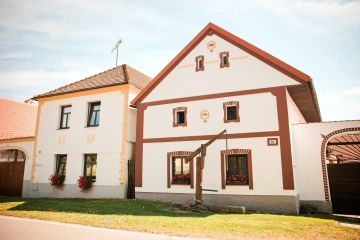Heritage care
We are doing everything we can to ensure that our village will last for generations to come.

We care about the history...
Holašovice was inscribed on the UNESCO List of Natural and Cultural Heritage for its exceptional architectural and urban values. They represent a unique preserved set of farmsteads, which were structurally and artistically modified during the 19th century into a specific form of the so-called peasant baroque, thanks to which these buildings are now the subject of monument protection.
Unique is the still intact form of the layout, plotting and structure of the buildings, which is an example of village urbanism from the peak phase of medieval colonisation.
Until the beginning of the 1950s, the farmsteads were used for individual farming - first by German old settlers, then, after the 1946 expulsion, briefly by the new Czech inhabitants. The turning point in the whole country came after 1948 with the rise of the communist regime. In the countryside, the layer of private farmers was gradually liquidated and there was a process of association and collectivisation.
The appearance of most rural settlements was negatively transformed, but fortunately Holašovice was almost spared these changes. Not entirely, but the impact on the building stock was not so significant. Although the agricultural cooperative used selected barns and sheds, it was not necessary to demolish them afterwards. Occasionally, some small farm buildings were demolished. The newly established co-operative farm and the new development were situated outside the boundary of the historic core of the village. Individual building and residential expansion during the 1970s, 1980s and early 20th century was also detrimental to the architectural appearance of the village, but some of the damage is now being repaired.
Efforts for area conservation have been underway since about 1958, when the Cultural Monuments Act came into force and Holašovice was included in the Central List of Cultural Monuments. Since then, the monument has also been gradually restored.
However, further efforts for area conservation have not been very successful. It was only the political, social and economic transformation after 1989 that brought changes in this area. In 1995, on the basis of a decree of the Government of the Czech Republic, 60 settlement units with monument protection were established in our territory, among which was also the Holašovice Village Monument Reserve.
At this time, preparatory actions for inscription on the UNESCO World Natural and Cultural Heritage List also began. This was successfully achieved on 5 December 1998 in Kyoto, Japan.
This inscription was an important milestone in the history of the village and brought many changes to the life of the villagers. In addition to more rigorous heritage protection, there has also been an increase in the pride of the local people. Until then, tourism was an almost non-existent industry, whereas today it brings more than 90,000 visitors to Holasovice every year.
Since then, a number of building renovations have been carried out, which have had a positive impact on the current appearance of the village. Many monuments have been restored to their historical appearance, some have been saved from extinction. After 1998, the historic buildings were gradually restored - first of all, the roofs were repaired, followed by the gradual rehabilitation of the village facades, which consisted of repairing damaged plaster and applying new lime coatings to all the homesteads on the basis of a professional survey of their colouring by the National Heritage Institute in České Budějovice. The village square was transformed - this large area was cultivated, trees were revitalized, the fire reservoir was transformed into a village pond. More attention is paid to the maintenance of public spaces and greenery. In addition to the village pond, the nearby Nekysel pond on the south-western edge of the village has been restored.
The village chapel of St. John of Nepomuk, as well as two small niche chapels, have also been completely renovated. An example of successful reconstruction is the restoration of the chalet in the yard of farmhouse No. 19 to its original form according to the surviving historical documentation and the comprehensive repair of the pigsty with a chicken coop in front of farmhouse No. 11, which is remarkable in its design.
Also unique is the restoration of 8 piston-operated water pumps to their original locations in the village square.
The development of tourism is also linked to the expansion of services. For example, there has been a complete renovation of the inn at No. 18 and the creation of another seasonal style pub in the granary at No. 3, a tourist information centre with a car park and a private agricultural museum, the Peasant Court at No. 6, and a ceramic workshop at No. 26.
At present, 23 farmsteads are protected, which together comprise more than 120 buildings. The vast majority of the farmsteads are permanently and year-round occupied, with only two in other uses. The main aim of the conservation area is not to create and preserve a museum complex, but to preserve Holašovice as a normal living village with a predominance of permanently inhabited farmsteads. This is also why land has been set aside in the historic core for new development, so that the continuity of settlement can be maintained, with the proportions and overall design of new buildings based on local building traditions.
Almost 90% of the buildings in the inhabited part of the village are of historic monument value. The oldest surviving buildings are two late medieval granaries - during the repair of the facade of the granary of farmhouse no. 15, original sgraffiti dating back to the end of the 16th century were uncovered. Approximately 40% of the buildings pre-date 1827, a further 40% date between 1828 and 1871, and a further 15% were built between 1871 and 1820. The remaining 5% of the buildings are of modern origin.
All repairs to both the exteriors and interiors are carried out in accordance with the requirements of the conservationists, but also in such a way as to conform to the ideas of modern housing. An essential prerequisite for preventive care is the carrying out of inspections, but first and foremost the provision of ongoing free professional assistance, help with administrative tasks, advice and consultation and the provision of basic information on rights and obligations arising from heritage legislation, on the possibilities of obtaining state subsidies for the maintenance and restoration of monuments and on the cultural and architectural and historical value of the village and individual farmsteads. The basic background material for the further development of the municipality is the Management Plan of the UNESCO World Heritage Site from 2008 to 2009.
Grant funds are mostly provided from the programme sources of the Ministry of Culture of the Czech Republic and from the grant titles of the South Bohemia Region.
Further information and interesting facts about folk architecture can be found e.g. on the website folk buildings.
















